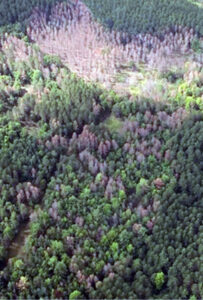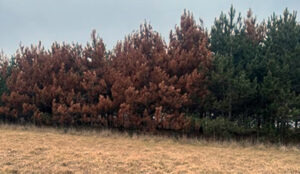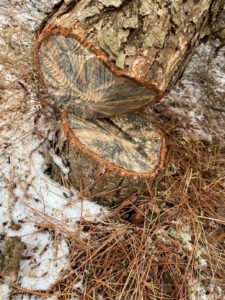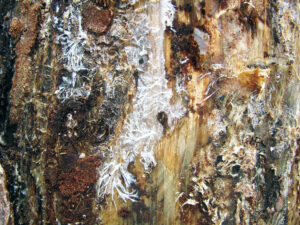
A swath of pine dead due to high water table mortality in 2020 in northeast Wisconsin.
By Alex Hornung, DNR Forest Health Specialist, Plover;
Alexandra.Hornung@wisconsin.gov
Many pine stands across central and northeast Wisconsin are being impacted by the change from high levels of precipitation to extreme drought that has occurred over the last 5-7 years.
Drastic or sudden changes can be particularly stressful to trees of all species, but especially to pine stands that prefer well-drained soil types.

A row of dying pine on excessively drained soils in 2024.
From 2017-2020, historic levels of precipitation took place; the wettest year on record in Wisconsin was 2019. Stress to pine associated with high levels of precipitation was highest in areas where the water table was within 3 feet in low areas of the stand and on soils that were slower to drain.
Then, in 2021, drought conditions arrived throughout the state, leading to another set of issues for pine stands on sandy soils. This had the exact opposite effect as the high-precipitation periods.

A drought-stressed pine with excessive blue-stain fungus carried by bark beetles, the causal agent of red pine pocket mortality and decline.
Drought stress was being observed in the high areas of stands, on soils that were excessively drained and where the water table was greater than 5 feet below ground.
Regardless of whether the stress originated from too much or too little precipitation, a cascade of events can happen in red pine stands that lead to mortality. Stressed trees attract bark beetles (all of which are native) that can cause additional stress. Occasionally, these bark beetles carry pathogenic fungi, most notably the fungus that causes the red pine pocket decline and mortality disease.
A tertiary agent that acts as the “final nail in the coffin” is Armillaria root rot. This is observed on pine regardless of the origin of the stress.
Management of pine damaged by abiotic stressors is very important. The standing dead/declining trees serve as reservoirs for populations of bark beetles that then move into adjacent pine. To capture value from the trees, salvage areas of mortality as quickly as possible. If the causal agent of red pine pocket decline and mortality is identified, it may be important to cut a buffer of healthy trees 33 to 66 feet from the last symptomatic tree within the area of decline. This would reduce the chance of losses around the edges of the pockets to the next entry into the stand.

Armillaria root rot white fungal structures are found under the bark of a pine killed by a high water table and flooding.
Your local forest health specialist can assist you in identifying if your red pine stand is experiencing stress and offer management recommendations. If your wooded area is greater than 10 acres, email photos to the DNR forest health specialist covering your area for more information.
